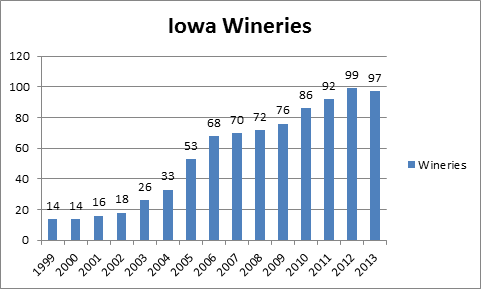by Michael Vincent, winemaker at Wooden Wheel Vineyards
The wine industry in Iowa has experienced extremely fast growth these last 10 years. In 2004 there were 27 wineries, in 2010 there were 94. At the end of 2013 there are 100. The era of rapid growth in the number of wineries is over.
In 2004 Iowa wineries produced 98,903 gallons of wine and in 2005 we sold 82,785. In 2012 we produced 296,909 gallons and in 2013 we sold 263,682. 2013 saw, for the first time, a decrease in the number of gallons sold from the prior year. Although that decrease is small, around 3,000 gallons, we are clearly entering a new phase in our industry.
No longer can we experience growth based on the novelty of an `Iowa produced wine’. Today you can go into your local convenience store, liquor store or Hy-Vee and find Iowa produced wines. Today we must compete with the Merlots and Chardonnays of the world that are on those same shelves to increase our wine sales.
The Iowa wine industry has 3 challenges as we move forward.
-
Educating the public on Iowa wines.
-
Improving our winemaking skills through education & research.
-
Improving the perception of Iowa produced wines.
No doubt these are substantial challenges that will go unmet without a combined and focused effort.
Fortunately, these challenges have not gone unrecognized. We have as an important resource the Midwest Wine and Grape Industry Institute located at Iowa State University. They provide the training, testing and research to help us make better wines. On February 4th the Iowa Wine Growers Association (IWGA) will be testifying before the Ag appropriations subcommittee for additional funding for the MWGII to increase their services and to lay the ground work for a potential research winery at ISU.
To help us improve the marketing of our wines, the IWGA has recently hired Emily Saveraid as the associations’ Marketing Director. This is an important step for the association as we work hard to help our members meet the challenges of the future. Please take advantage of the opportunity to meet her at the upcoming IWGA Conference in March.
The state of the wine industry, from my perspective, appears very to be good and with a continued effort from everyone, can be even better.
Michael Vincent
IWGA Board Member
